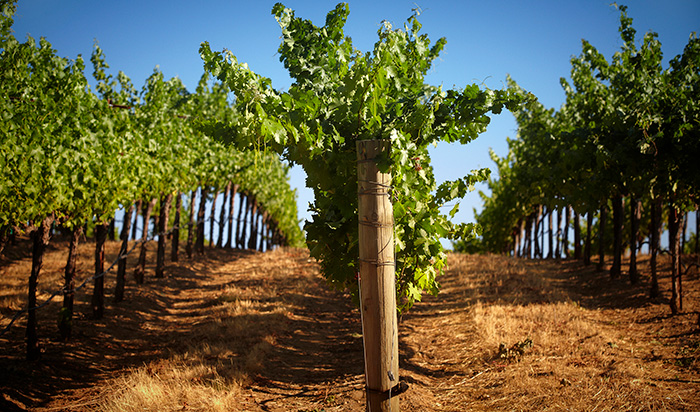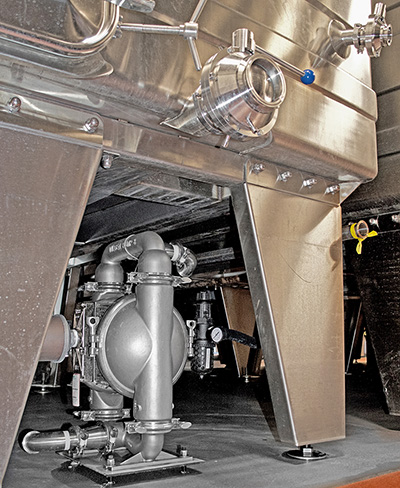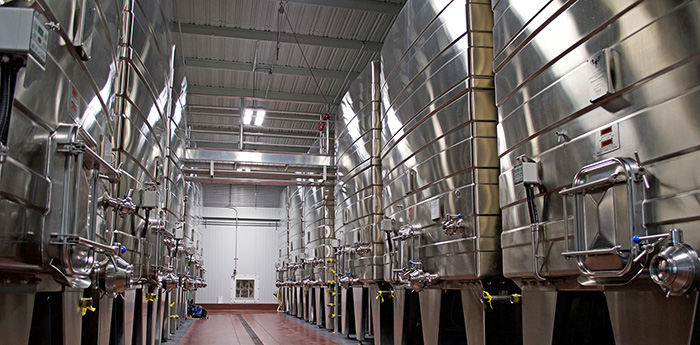When Rodney Strong Vineyards built its new 10,500-square-foot fermentation facility in Healdsburg, California, to accommodate premium grapes from its Cooley Ranch Vineyard, each detail was precisely planned. All equipment was carefully engineered or researched before purchase to ensure efficient operation and optimal product handling. One critical component involved selecting pumps that irrigate the fruit cap at the top of the fermentation tank.
 Image 1. Founded in 1959, Rodney Strong Vineyards has earned a reputation for critically acclaimed wines, earning Wine Enthusiast’s American Vineyards of the Year award in 2013. (Images courtesy of Wilden)
Image 1. Founded in 1959, Rodney Strong Vineyards has earned a reputation for critically acclaimed wines, earning Wine Enthusiast’s American Vineyards of the Year award in 2013. (Images courtesy of Wilden) Rodney Strong conducted exhaustive research and testing to identify the best pump and diaphragm technology for the application. The vineyard looked for equipment that would provide energy efficiency, reduced maintenance, ease of use, cleanability, reliability and gentle handling of the product for optimal fermentation.
State-of-the-Art Cellar
Nestled in California’s rugged northwestern Sonoma County, the remote 200-acre Cooley Ranch Vineyard produces high-Bordeaux Varietals in its volcanic soils. To best accommodate the prized harvests from this property, Rodney Strong built a new state-of-the-art cellar with 51 6,000-gallon stainless-steel fermentation tanks.
From the project’s onset, Rodney Strong personnel sought highly specialized equipment to ensure that the fermentation process would follow the company’s precise production standards while maximizing energy and labor efficiency. Square tanks, rather than traditional circular tanks, were constructed to maximize floor space. Cutting-edge electronic controllers were installed on all tanks to automatically and precisely control product temperature and support equipment operation throughout the fermentation process.
Cap Irrigation Challenges
An important requirement during the fermentation process is managing the fruit cap that forms at the top of the tank in order to prevent hardening. In a process known as “pumping over,” the operation requires the pump to draw juice from just above the seed layer near the bottom of the fermentation tank and pump it to the top of the tank.
At Rodney Strong, the juice is sent through a flinger device and an oxygen-inducing nozzle that spreads the juice to completely cover the cap and keep it wet. Juice is pumped for 20-minute periods up to three times per day.
Like many wineries, Rodney Strong has primarily used centrifugal pumps for this purpose; however, experience has shown that centrifugal pumps tend to grind and break up any grape seeds that are sucked in by the pump and become part of the flow.
The ground seeds introduce a large quantity of tannins into the wine, which adversely affects product quality. Because of this pump drawback, Rodney Strong sought alternative pump technologies that would reduce or eliminate grinding the seeds.
 Image 2. A change in pump technology helps to provide maximum cleanability and energy savings for cap irrigation at Rodney Strong Vineyards.
Image 2. A change in pump technology helps to provide maximum cleanability and energy savings for cap irrigation at Rodney Strong Vineyards. Testing Various Pumps
Rodney Strong Cellar Master Manuel Villanueva played a key role in selecting the best pump for irrigating the cap. “We had strict requirements that the pump provide gentle product handling, energy efficiency, ease of cleaning and operational reliability,” he said. “Our challenge was to identify the best technology available to meet those goals.”
Rodney Strong turned to Pumping Solutions Inc., in Hayward, California, a pump and process equipment supplier that has a long history of working with the wine industry. Based on Rodney Strong’s requirements, Pumping Solutions sales engineers Pat Mooney and Ben Touzinsky suggested the air-operated double-diaphragm (AODD) pump.
“The first issue we addressed was product handling, and we suggested the AODD pump as the natural solution because of its excellent shear sensitivity,” Mooney said. “The AODD pump’s gentle product handling circulates the liquid for the pumping-over process without damaging the juice.”
AODD pumps offer durability and flexibility not available in centrifugal or progressive cavity pumps. “Additional reasons why we proposed AODD pumps is that they have the ability to run dry with no damage, deadhead without problems and allow easy liquid flow rate adjustment by simply changing the air flow,” Touzinsky said. “They are also easy to install and operate.”
Because of Rodney Strong’s high standards and commitment to quality, the vineyard’s next step was to conduct extensive tests on AODD, centrifugal and progressive cavity pumps to determine which type would best meet its qualifications.
“Based on our tests, we concluded that AODD pumps are the superior pump for the overall quality of the juice in the fermentation process,” said Villanueva, who oversaw the pump comparison tests. “The AODD pump was clearly the best in helping to extract the juices as well as control the desired tannins and color from each grape varietal that we put in. Based on those results, we decided to utilize AODD pumps.”
In addition, the vineyard’s managers found that AODD pumps provided the reliability needed for their operations. “With AODD pumps, we know that when we set the air pressure, it will maintain the required flow consistently,” Villanueva said. “These pumps are extremely efficient and reliable in pumping the product through.”
Energy Efficiency Tests
Once Rodney Strong decided to standardize on AODD pumps, the vineyard needed to evaluate pumps from different manufacturers for performance, quality, energy efficiency and ease of maintenance. One critical criterion was pump air consumption.
“We were utilizing a smaller air compressor, so our goal was to find an energy-efficient pump that could be driven by our current equipment,” Rodney Strong Winemaker Justin Seidenfeld said. “Our staff worked with Pat Mooney to conduct extensive pump research comparing specifications, features and performance.”
Villanueva and Rodney Strong Maintenance Technician Richard Ivaldi met with Pumping Solutions to conduct performance tests and examine the quality of various manufacturers’ AODD pumps. “We tested different pumps from different manufacturers so we could evaluate the performance and air consumption of each at the same air pressure,” Villanueva said.
Villanueva noted that all could pump juice, but one in particular demonstrated higher efficiency. The selected pump required less air consumption—reduced standard cubic feet per minute (SCFM)—and could “provide the same liquid flow as pumps from other manufacturers, giving us much greater efficiency and energy savings,” he said.
Reduced air consumption is realized by using pump technology that incorporates a unique air control spool that automatically restricts the amount of air going into the pump during the latter part of each stroke. This eliminates over-filling of the air chamber and results in reduced energy consumption. By optimizing air consumption, the technology can lower energy and operating costs, achieving up to 60 percent savings over some other AODD pump technologies.
 Rodney Strong Vineyards’ new 10,500-square-foot state-of-the-art cellar in Healdsburg, California, utilizes 51 6,000-gallon stainless-steel fermentation tanks to accommodate premium grapes from their Cooley Ranch Vineyard.
Rodney Strong Vineyards’ new 10,500-square-foot state-of-the-art cellar in Healdsburg, California, utilizes 51 6,000-gallon stainless-steel fermentation tanks to accommodate premium grapes from their Cooley Ranch Vineyard.Easy Cleanability
Sanitary practices are critical in all winemaking operations, and pumps that move wine are required to comply with the U.S. Food and Drug Administration’s (FDA) Code of Federal Regulations (CFR) 21.177 standards, which is titled “Indirect Food Additives: Polymers” under the subsection pertaining to “Food for Human Consumption.” The selected pump features 316 stainless steel wetted parts with an Ra 1.3 μm (51.2 μin) interior polish that fully meet FDA standards.
“In addition to meeting FDA standards, cleanability was a very important factor to consider in our evaluation process for efficiency and labor savings,” Villanueva said. The selected pumps “utilize tri-clamps for extremely quick disassembly and assembly to save labor in the sanitization process. In addition, the overall pump design makes cleaning easy. We know that good sanitization processes help assure you produce a good wine, and that’s part of maintaining our high quality.”
The selected pump also uses a specialized diaphragm that encapsulates the outer piston completely. Mooney said the diaphragm’s design “totally eliminates the cracks and crevices inherent with traditional diaphragms where the bacteria can hide.”
Additionally, the full-stroke design provides increased displacement per stroke, resulting in higher productivity for enhanced flow rates and 115 percent greater suction lift. This operational efficiency allows for fewer strokes for the same performance, which reduces energy consumption and extends diaphragm life.
Rodney Strong tested the new cellar during the 2015 season. After the initial order of 16 AODD pumps, Rodney Strong has ordered an additional 43 pumps to complete the outfitting of the cellar.


